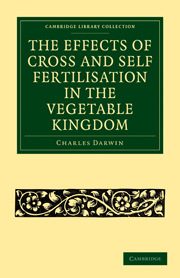Book contents
- Frontmatter
- Contents
- CHAPTER I INTRODUCTORY REMARKS
- CHAPTER II CONVOLVULACEÆ
- CHAPTER III SCROPHULARIACEÆ, GESNERIACEÆ, LABIATÆ, ETC
- IV CRUCIFERÆ, PAPAVERACEÆ, RESEDACEÆ, ETC
- CHAPTER V GERANIACEÆ, LEGUMINOSÆ, ONAGRACEÆ, ETC
- CHAPTER VI SOLANACEÆ PRIMULACEÆ, POLYGONEÆ, ETC
- CHAPTER VII SUMMARY OF THE HEIGHTS AND WEIGHTS OF THE CROSSED AND SELF-FERTILISED PLANTS
- CHAPTER VIII DIFFERENCE BETWEEN CROSSED AND SELF-FERTILISED PLANTS IN CONSTITUTIONAL VIGOUR AND IN OTHER RESPECTS
- CHAPTER IX THE EFFECTS OF CROSS-FERTILISATION AND SELF-FERTILISATION ON THE PRODUCTION OF SEEDS
- CHAPTER X MEANS OF FERTILISATION
- CHAPTER XI THE HABITS OF INSECTS IN RELATION TO THE FERTILISATION OF FLOWERS
- CHAPTER XII GENERAL RESULTS
- INDEX
CHAPTER II - CONVOLVULACEÆ
Published online by Cambridge University Press: 29 August 2010
- Frontmatter
- Contents
- CHAPTER I INTRODUCTORY REMARKS
- CHAPTER II CONVOLVULACEÆ
- CHAPTER III SCROPHULARIACEÆ, GESNERIACEÆ, LABIATÆ, ETC
- IV CRUCIFERÆ, PAPAVERACEÆ, RESEDACEÆ, ETC
- CHAPTER V GERANIACEÆ, LEGUMINOSÆ, ONAGRACEÆ, ETC
- CHAPTER VI SOLANACEÆ PRIMULACEÆ, POLYGONEÆ, ETC
- CHAPTER VII SUMMARY OF THE HEIGHTS AND WEIGHTS OF THE CROSSED AND SELF-FERTILISED PLANTS
- CHAPTER VIII DIFFERENCE BETWEEN CROSSED AND SELF-FERTILISED PLANTS IN CONSTITUTIONAL VIGOUR AND IN OTHER RESPECTS
- CHAPTER IX THE EFFECTS OF CROSS-FERTILISATION AND SELF-FERTILISATION ON THE PRODUCTION OF SEEDS
- CHAPTER X MEANS OF FERTILISATION
- CHAPTER XI THE HABITS OF INSECTS IN RELATION TO THE FERTILISATION OF FLOWERS
- CHAPTER XII GENERAL RESULTS
- INDEX
Summary
A plant of Ipomoea purpurea, or as it is often called in England the convolvulus major, a native of South America, grew in my greenhouse. Ten flowers on this plant were fertilised with pollen from the same flower; and ten other flowers on the same plant were crossed with pollen from a distinct plant. The fertilisation of the flowers with their own pollen was superfluous, as this convolvulus is highly self-fertile; but I acted in this manner to make the experiments correspond in all respects. Whilst the flowers are young the stigma projects beyond the anthers; and it might have been thought that it could not be fertilised without the aid of humble-bees, which often visit the flowers; but as the flower grows older the stamens increase in length, and their anthers brush against the stigma, which thus receives some pollen. The number of seeds produced by the crossed and self-fertilised flowers differed very little.
Crossed and self-fertilised seeds obtained in the above manner were allowed to germinate on damp sand, and as often as pairs germinated at the same time they were planted in the manner described in the Introduction, on the opposite sides of two pots. Five pairs were thus planted; and all the remaining seeds, whether or not in a state of germination, were planted on the opposite sides of a third pot, so that the young plants on both sides were here greatly crowded and exposed to very severe competition.
- Type
- Chapter
- Information
- Publisher: Cambridge University PressPrint publication year: 2009First published in: 1876

